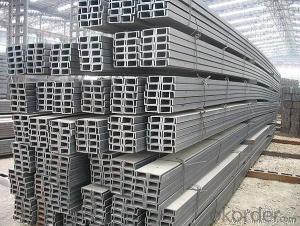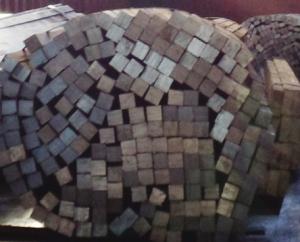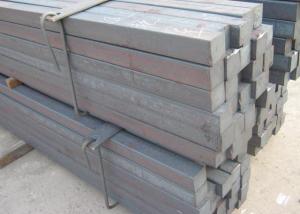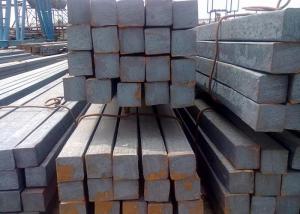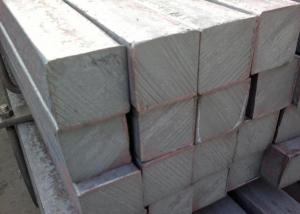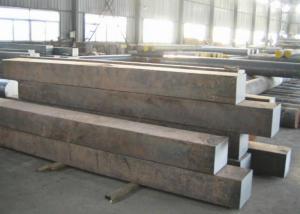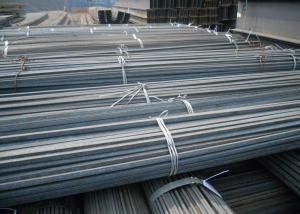Square bar 5mm-100mm
- Loading Port:
- China Main Port
- Payment Terms:
- TT OR LC
- Min Order Qty:
- -
- Supply Capability:
- -
OKorder Service Pledge
OKorder Financial Service
You Might Also Like
Product Description:
We offer Square Steel Bar with grade Q195 / Q235
Specifications of Square Steel Bar:
-Standard: GB,
-Grade: Q195/Q235 or equivalent.
Chemical Composition:
-Chemical Composition. Q195
Standard | Grade | Element (%) | ||||
GB | Q195 | C | Mn | S | P | Si |
0.06~0.12 | 0.25~0.50 | ≤0.050 | ≤0.045 | ≤0.30 | ||
-Chemical Composition. Q235
Standard | Grade | Element (%) | ||||
GB | Q235B | C | Mn | S | P | Si |
0.12~0.20 | 0.30~0.70 | ≤0.045 | ≤0.045 | ≤0.30 | ||
Measures and Tolerances of Square Steel Bar:

(The section of Square Steel Bar)
-The length of a side and the theoretical weight of Square Steel.
Length of a side(a, mm) | Theoretical weight(kg/m) | Length of a side(a, mm) | Theoretical weight(kg/m) |
6 | 0.283 | 32 | 8.04 |
7 | 0.385 | *33 | 8.55 |
8 | 0.502 | 34 | 9.07 |
9 | 0.636 | *35 | 9.62 |
10 | 0.785 | 36 | 10.17 |
11 | 0.950 | 38 | 11.24 |
12 | 1.13 | 40 | 12.56 |
13 | 1.33 | 42 | 13.85 |
14 | 1.54 | 45 | 15.90 |
15 | 1.77 | 48 | 18.09 |
16 | 2.01 | 50 | 19.63 |
17 | 2.27 | 53 | 22.05 |
18 | 2.54 | *55 | 23.6 |
19 | 2.82 | 56 | 24.61 |
20 | 3.14 | *58 | 26.4 |
21 | 3.46 | 60 | 28.26 |
22 | 3.80 | 63 | 31.16 |
*23 | 4.15 | *65 | 33.17 |
24 | 4.52 | *68 | 36.3 |
25 | 4.91 | 79 | 38.49 |
26 | 5.30 | 75 | 44.16 |
*27 | 5.72 | 80 | 50.24 |
28 | 6.15 | 85 | 56.72 |
*29 | 6.60 | 90 | 63.59 |
30 | 7.06 | 95 | 70.85 |
*31 | 7.54 | 100 | 78.50 |
Notes:
1, The theoretical weights in the list, base on the density of 7.85 g/cm3.
2, The numbers with *mean that they are not regulars or we don’t offer them.
-The allowed tolerance of Square Steel:
Length of a side(mm) | Allowed Tolerance | ||
Group1 | Group2 | Group3 | |
5.5~7 | ±0.20 | ±0.30 | ±0.40 |
7~20 | ±0.25 | ±0.35 | ±0.40 |
20~30 | ±0.30 | ±0.40 | ±0.50 |
30~50 | ±0.40 | ±0.50 | ±0.60 |
60~80 | ±0.60 | ±0.70 | ±0.80 |
80~110 | ±0.90 | ±1.0 | ±1.1 |
110~150 | ±1.2 | ±1.3 | ±1.1 |
150~190 | ―― | ―― | ±2.0 |
190~250 | ―― | ―― | ±2.5 |
Usage/Applications of Steel Square Bar:
-The Square Steel is normally used as structure steel.
-Row material for other structure steel like steel angles, channels, I-beams, H-beams, etc…
Packaging & Delivery of Steel Square Bar:
-Packing Detail: The products can be packed in bundles by steel wires.
-Marks:
1, Tag marks: the tag marks will be tied up to each bundle of the products. The information is usually including supplier’s logo and name, product name, made in China, products’ specifications, the painted color and other information requested by customers.
2, Color marks: we will paint both ends of the bundles of these products to make sure that they are more evident. It’s will be more convenient for the customers to distinguish them at the destination port.
-Delivery Detail: 30~45 working days after receive buyer’s T.T. or L/C.
Transportation:
-The products can be delivered by bulk vessel or by container. As for container, products with the length of 6m will be loaded in 20’ container, with 9m or 12m, in 40’ container.
-The maximum quantity of loading of container is 25 tons.
-The products usually are transported to the nearest port from the production place.
Payment:
-Invoicing on theoretical weight or actual weight a s customer’s request.
-FOB, CFR or CIF.
-Regular terms of payment:
1, 30% payment in advance, the remaining balance (70% payment) against the copy of B/L.
2, 30% payment in advance, the remaining balance (70% L/C) against the copy of B/L.
3, Negotiable.
- Q: How do you use a steel square to determine the angle of a routing template cut?
- To use a steel square to determine the angle of a routing template cut, you can follow these steps: 1. Place the steel square on the edge of the routing template, aligning one side of the square with the edge of the template. 2. Adjust the square until the other side of the square is parallel to the edge of the template. 3. Once the square is properly aligned, read the angle measurement on the square's scale or protractor. 4. This measurement will give you the angle of the routing template cut, which can then be used to set up your routing tool or guide the cutting process.
- Q: Can a steel square be used for framing walls?
- Yes, a steel square can be used for framing walls. Steel squares, also known as framing squares or carpenter squares, are versatile tools that can be used in various construction tasks, including framing walls. They are typically made of steel and have a 90-degree angle, making them suitable for measuring and marking right angles, laying out cuts, and checking the squareness of walls during framing.
- Q: Can a steel square be used for gazebo layout and construction?
- Gazebo layout and construction can greatly benefit from the utilization of a steel square. This versatile tool, also referred to as a framing square, is widely employed by carpenters and builders to guarantee precise measurements and angles during construction endeavors. Comprised of two arms forming a right angle, one of which is longer and features a graduated scale for convenient measurement, the steel square is an invaluable asset. In the realm of gazebo layout and construction, the steel square proves to be highly advantageous. Its application extends to marking and arranging the foundation, ensuring the corners are square and the angles are accurate. Furthermore, it aids in measuring and delineating the lengths and angles of various gazebo components, including posts, beams, and rafters. Moreover, the steel square serves as a valuable tool for assessing and adjusting the squareness of the gazebo structure throughout the construction process. By placing the square against the corners and edges of the gazebo, any discrepancies in angles can be swiftly identified and rectified. In conclusion, the steel square plays a vital role in gazebo layout and construction, affording accuracy, precision, and the assurance that the structure is assembled correctly.
- Q: Can a steel square be used for checking the alignment of walls?
- Checking the alignment of walls can be done using a steel square. A steel square, also called a framing square, is a versatile tool commonly utilized in carpentry and other construction tasks. It comprises a flat, triangular piece of steel with various measurements and angles marked on its surface. To assess wall alignment, position the steel square against the wall's surface, ensuring that one edge of the square is flush with the wall. By visually examining the square against the wall, any misalignments can be easily identified. For instance, if the square does not sit flush with the wall along its entire length, it signifies that the wall is not perfectly straight or aligned. Moreover, the marked angles on the steel square can be used to verify the squareness of wall corners. By placing the square in a corner and checking if the edges align with the walls, any deviations from a precise 90-degree angle can be detected. Overall, even though a steel square may not be the most accurate tool for assessing wall alignment, it certainly offers a reliable indication of any irregularities. It is a straightforward and cost-effective tool that can be effectively utilized by both professionals and DIY enthusiasts to ensure the precision and quality of wall construction.
- Q: What are the common applications of a steel square in metalworking projects?
- A steel square is commonly used in metalworking projects for various applications such as measuring and marking right angles, checking the flatness or squareness of a workpiece, drawing straight lines, and ensuring accurate cuts and layouts. It is a versatile tool that helps in achieving precision and maintaining the desired dimensions in metalworking projects.
- Q: How do you use a steel square to measure diagonals?
- To use a steel square to measure diagonals, simply place the square against the corner of the object or surface you want to measure. Align one edge of the square with one side of the object and make sure the other edge is perpendicular to it. Then, measure the diagonal by extending the other edge of the square until it reaches the opposite corner. The measurement you obtain is the length of the diagonal.
- Q: Can a steel square be used for checking the squareness of floor tiles?
- Yes, a steel square can be used for checking the squareness of floor tiles. A steel square is a precision measuring tool that has a right angle shape, making it suitable for checking if floor tiles are laid at a perfect 90-degree angle. By placing the steel square against the corners of the tiles, one can easily determine if they are properly aligned and square. The straight edges of the square can also be used to ensure that the tiles are laid in straight lines. However, it is important to note that other tools such as a carpenter's square or a T-square can also be used for this purpose, depending on personal preference and availability.
- Q: How do you use a steel square to create dovetail joints?
- To use a steel square to create dovetail joints, you will need a few additional tools such as a marking gauge, a chisel, a mallet, and a dovetail saw. 1. Start by marking out the tails on the end grain of the board that you want to create the dovetail joint on. Use the steel square to ensure the lines are at a 90-degree angle to the face of the board. 2. Next, set the marking gauge to the desired width of the tails and use it to scribe lines across the face grain of the board. The steel square can help you ensure the lines are perpendicular to the face. 3. Now, using the dovetail saw, carefully cut along the scribed lines on the face grain. The steel square can be used to guide the saw to maintain a straight and square cut. 4. Once the tails are cut, use the steel square to transfer the shape of the tails onto the board that will receive the dovetail joint. Hold the square against the tails and trace along the edges to mark the corresponding pins. 5. With the pins marked, use the marking gauge to scribe lines across the face grain of the receiving board. Again, make sure the lines are at a 90-degree angle to the face using the steel square. 6. Now, carefully cut along the scribed lines on the receiving board using the dovetail saw. Make sure to cut just outside the lines to leave room for fitting the joint together. 7. After cutting the pins, you can use a chisel and mallet to remove the waste material between the pins. The steel square can help you ensure the chisel is held perpendicular to the face to create clean and accurate cuts. 8. Finally, test fit the joint by assembling the tails into the pins. If any adjustments are needed, use the chisel and mallet to carefully remove excess material until the joint fits tightly and securely. Remember to always work with caution and precision when using any tools, especially sharp ones. Practice on scrap wood before attempting dovetail joints on your actual project to gain confidence and improve your skills.
- Q: How does a steel square assist in laying out stairs?
- A steel square assists in laying out stairs by providing accurate measurements and angles for cutting stringers, determining the rise and run of each step, and ensuring precise alignment during the construction process.
- Q: Can a steel square be used for checking the squareness of a table saw sled?
- Yes, a steel square can be used to check the squareness of a table saw sled. The straight edges of a steel square can be aligned with the edges of the sled to determine if it is perfectly square or if any adjustments need to be made.
Send your message to us
Square bar 5mm-100mm
- Loading Port:
- China Main Port
- Payment Terms:
- TT OR LC
- Min Order Qty:
- -
- Supply Capability:
- -
OKorder Service Pledge
OKorder Financial Service
Similar products
Hot products
Hot Searches
Related keywords
